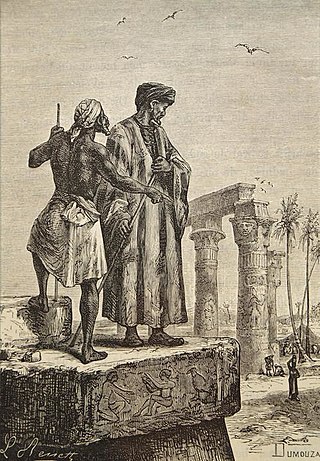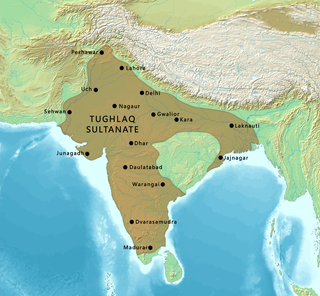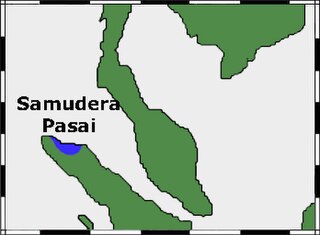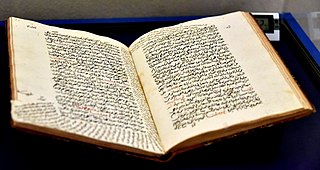
Abū Abd Allāh Muḥammad ibn Abd Allāh Al-Lawātī, commonly known as Ibn Battuta, was a Maghrebi traveller, explorer and scholar. Over a period of thirty years from 1325 to 1354, Ibn Battuta visited most of North Africa, the Middle East, East Africa, Central Asia, South Asia, Southeast Asia, China, the Iberian Peninsula, and West Africa. Near the end of his life, he dictated an account of his journeys, titled A Gift to Those Who Contemplate the Wonders of Cities and the Marvels of Travelling, but commonly known as The Rihla.

The 7th century is the period from 601 through 700 in accordance with the Julian calendar in the Christian Era.

Year 635 (DCXXXV) was a common year starting on Sunday of the Julian calendar. The denomination 635 for this year has been used since the early medieval period, when the Anno Domini calendar era became the prevalent method in Europe for naming years.
The Xi'an Stele or the Jingjiao Stele, sometimes translated as the "Nestorian Stele," is a Tang Chinese stele erected in 781 that documents 150 years of early Christianity in China. It is a limestone block 279 centimetres high with text in both Chinese and Syriac describing the existence of Christian communities in several cities in northern China. It reveals that the initial Church of the East had met recognition by the Tang Emperor Taizong, due to efforts of the Christian missionary Alopen in 635. According to the stele, Alopen and his fellow Syriac missionaries came to China from Daqin in the ninth year of Emperor Taizong (635), bringing sacred books and images. The Church of the East monk Adam composed the text on the stele. Buried in 845, probably during religious suppression, the stele was not rediscovered until 1625. It is now in the Stele Forest in Xi'an.

Quanzhou is a prefecture-level port city on the north bank of the Jin River, beside the Taiwan Strait in southern Fujian, People's Republic of China. It is Fujian's largest most populous metropolitan region, with an area of 11,245 square kilometers (4,342 sq mi) and a population of 8,782,285 as of the 2020 census. Its built-up area is home to 6,669,711 inhabitants, encompassing the Licheng, Fengze, and Luojiang urban districts; Jinjiang, Nan'an, and Shishi cities; Hui'an County; and the Quanzhou District for Taiwanese Investment. Quanzhou was China's 12th-largest extended metropolitan area in 2010.

Book of the Marvels of the World, in English commonly called The Travels of Marco Polo, is a 13th-century travelogue written down by Rustichello da Pisa from stories told by Italian explorer Marco Polo. It describes Polo's travels through Asia between 1271 and 1295, and his experiences at the court of Kublai Khan.

Alopen is the first recorded Assyrian Christian missionary to have reached China, during the Tang dynasty. He was a missionary from the Church of the East, and probably a Syriac speaker from the Sasanian Empire or from Byzantine Syria. He is known exclusively from the Xi'an Stele, which describes his arrival in the Tang capital of Chang'an in 635 and his acceptance by Emperor Taizong of Tang. His is the earliest known name that can be attached to the history of the Church of the East in China.

The Tughlaq dynasty was the third dynasty to rule over the Delhi sultanate in medieval India. Its reign started in 1320 in Delhi when Ghazi Malik assumed the throne under the title of Ghiyath al-Din Tughluq. The dynasty ended in 1413.

The Church of the East historically had a presence in China during two periods: first from the 7th through the 10th century in the Tang dynasty, when it was known as Jingjiao, and later during the Yuan dynasty in the 13th and 14th centuries, when it was described alongside other foreign religions like Catholicism and possibly Manichaeism as Yelikewen jiao.

Jian'ou is a county-level city in Nanping in northern Fujian province, China. Under the name Jianning (Kienning), it was formerly the seat of its own prefecture and was the namesake of its province.

The Samudera Pasai Sultanate, also known as Samudera or Pasai or Samudera Darussalam or Pacem, was a Muslim kingdom on the north coast of Sumatra from the 13th to the 16th centuries.
Urduja was a legendary warrior princess recorded in the travel accounts of Ibn Battuta. She was described to be a princess of Kaylukari in the land of Tawalisi. Though the locations of Kaylukari and Tawalisi are disputed, in the Philippines, Urduja is believed by modern Filipinos to be from Pangasinan, and has since been regarded as a national heroine.

Sultan Malikussaleh is an Acehnese who established the first Muslim state of Samudera Pasai in the year 1267. His original name was Mara Silu, Merah Silu, or Meurah Silu. It was said he saw an ant as big as a cat, he caught it and ate it. He named the place Samudera, meaning ocean in Sanskrit (samudra). King Mara Silu later converted to Islam, given an Ayyubid name of al-Malik al-Ṣālih. He married neighbour Perlak (Peureulak) Kingdom's daughter and had two sons. According to Hikayat Raja-raja Pasai, he met the Islamic prophet Muhammad in dream thus accepts conversion of Islam. Another source claimed a prince Malik from Aceh sailed across the sea to Beruas and established a sultanate there.

Qalhāt is a village in Oman, over 20 km north of Sur. The residential area is to the northwest of Wādī Ḥilm, and the ruins of the ancient city are located to the southeast. The ancient city is referred to as Calatu by Marco Polo and as Calha in the map of Abraham Ortelius.
The Port of Meizhou Bay was created in 2012 by merging the ports of Quanzhou, Meizhou Island and Putian, as part of Fujian Province's rationalization of ports, which cutting down the number of ports in the province into three large consolidated ports. In 2012, Meizhou Bay port had 147 berths, 24 with 10,000DWT capacity, and had a total cargo throughput of 114 million tonnes.

The Sultanate of Mogadishu, also known as Kingdom of Magadazo, was a medieval Muslim sultanate centered in southern Somalia. It rose as one of the pre-eminent powers in the Horn of Africa under the rule of Fakhr al-Din before becoming part of the powerful and expanding Ajuran Sultanate in the 13th century. The Mogadishu Sultanate maintained a vast trading network, dominated the regional gold trade, minted its own currency, and left an extensive architectural legacy in present-day southern Somalia.

Indonesia and Morocco established diplomatic relations in 1960. Both are the Muslim-majority countries; Indonesia is the most populous Muslim country in the world, while Morocco is also a Muslim majority nation. Morocco praised Indonesia as a strong democratic nation, and pointed out that both nations face the same challenges of separatism and terrorism. Diplomatic relations were established in 1960. Indonesia has an embassy in Rabat and a consulate in Casablanca, while Morocco has an embassy in Jakarta. Both nations are members of the World Trade Organization (WTO), Group of 77, Non-Aligned Movement and Organisation of Islamic Cooperation (OIC).

Phoenix Mosque is a mosque in Hangzhou, Zhejiang, China. It is known for being one of the four great mosques of China. It is also one of the earliest mosque built in China. The origin of this mosque dates back to the Tang or Song dynasty.

The Rihla, formal title A Masterpiece to Those Who Contemplate the Wonders of Cities and the Marvels of Traveling, is the travelogue written by Ibn Battuta, documenting his lifetime of travel and exploration, which according to his description covered about 73,000 miles. Rihla is the Arabic word for a journey or the travelogue that documents it.















